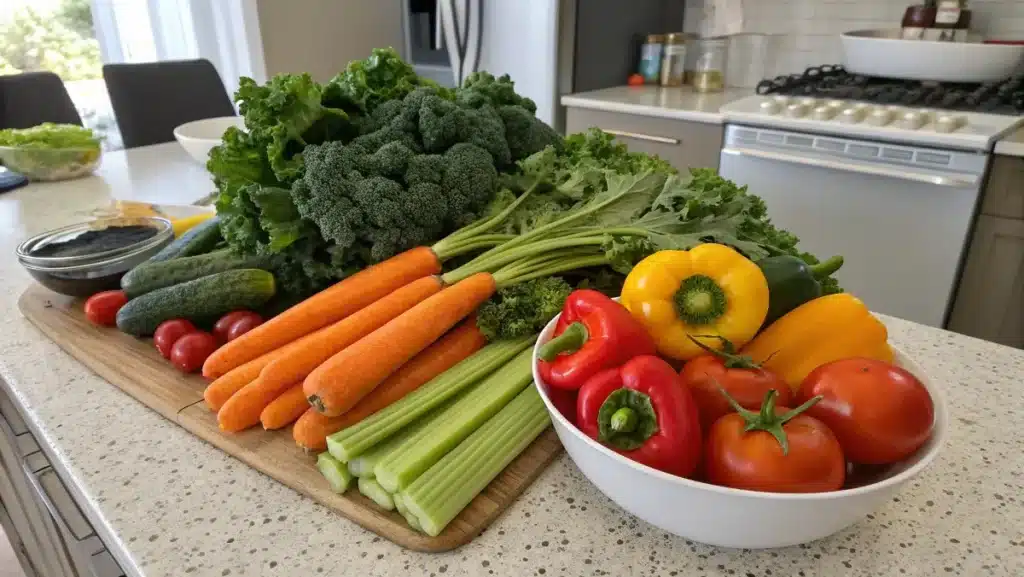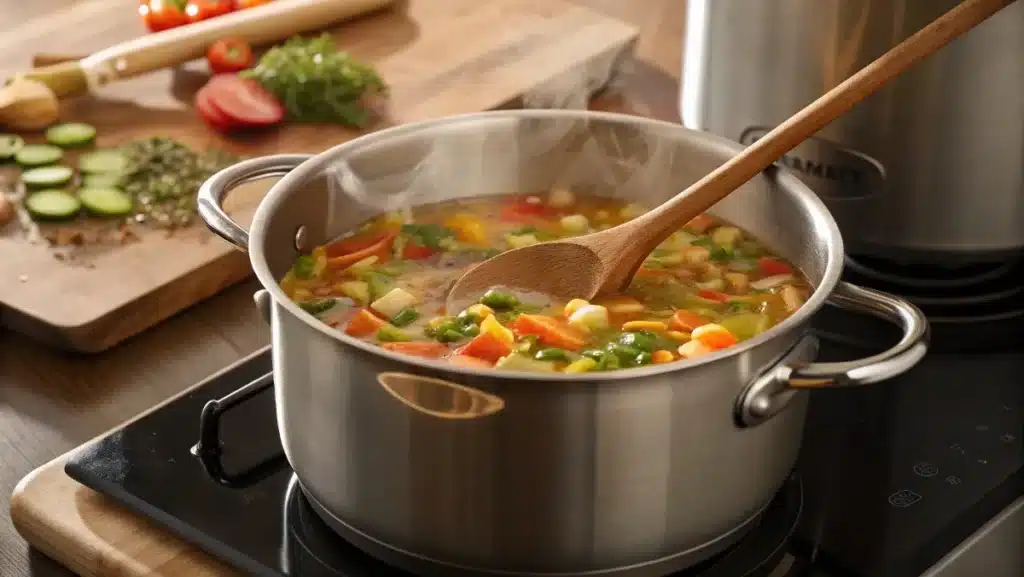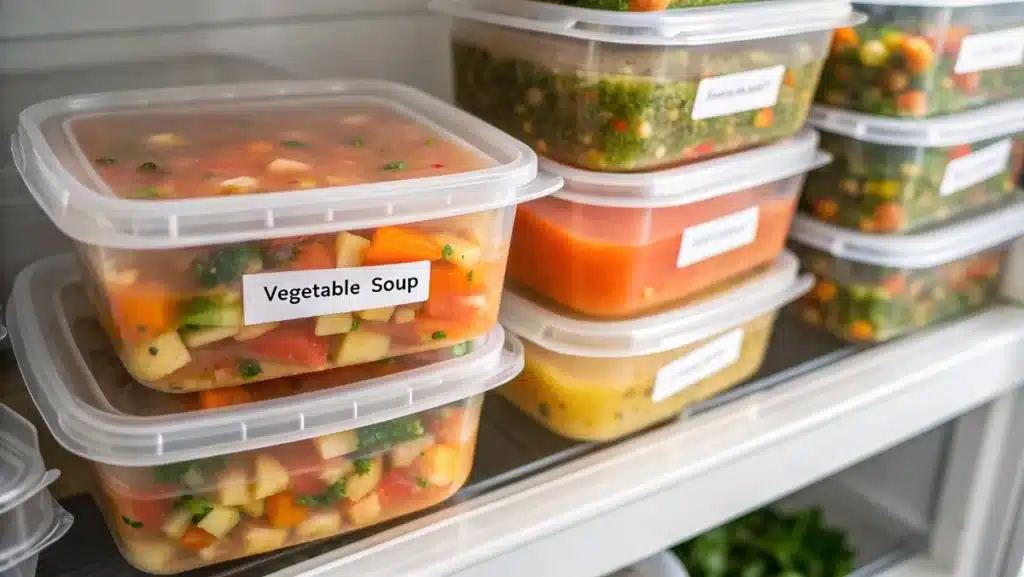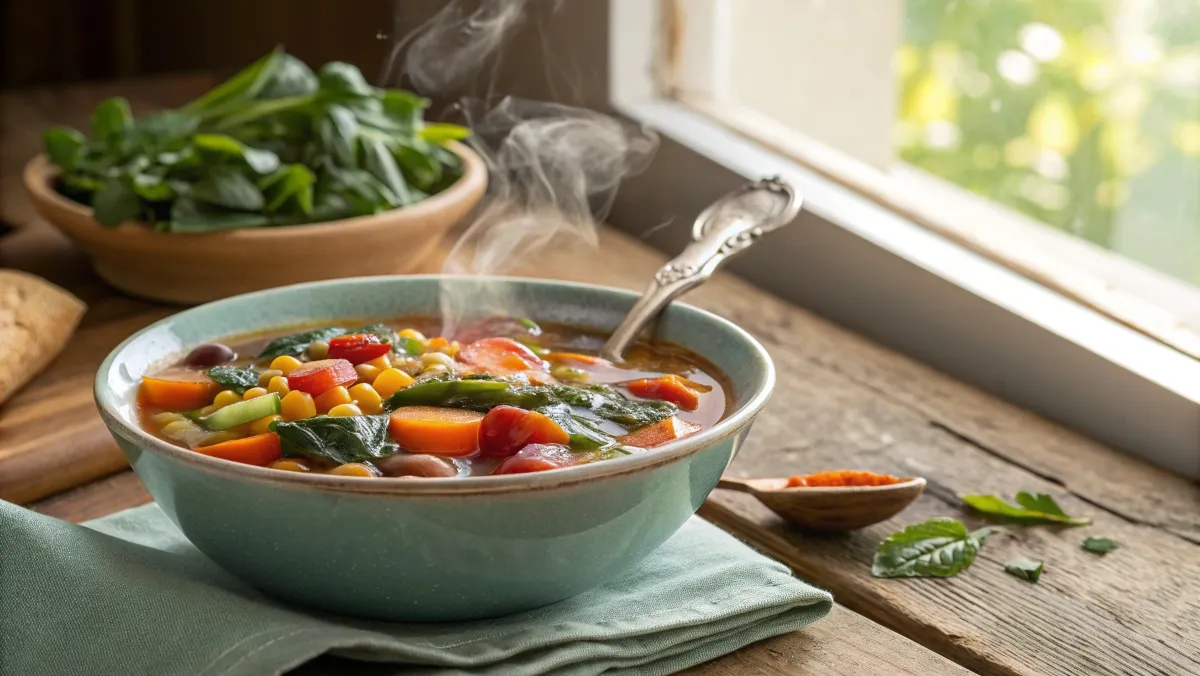10 Vegetable Soup Recipe (Easy, Flavorful, and Nourishing Guide)
If you’re searching for a hearty, healthy, and affordable meal idea, this 10 vegetable soup recipe is the ultimate go-to. Packed with vitamins, fiber, and deep flavors, this soup is both satisfying and nourishing. It’s the perfect choice whether you’re following a plant-based diet, looking to clean up your meals, or just need a comfort dish that’s loaded with veggies.
In this guide, we’ll show you exactly how to make this soup from scratch, including how to build flavor, avoid common cooking mistakes, and customize it to your preferences. From stovetop to slow cooker options, we’ve got you covered. We’ll also dive into the nutritional value, the best vegetables to use, and expert-level soup-making tips.
Check out vegan-yum-yum-sauce-recipe for a flavor-packed drizzle that pairs perfectly with veggie soups.
Table of Contents
Why You’ll Love This 10 Vegetable Soup Recipe
Simple, Versatile, and Nutrient-Packed
What makes this 10 vegetable soup recipe stand out is its simplicity and adaptability. You can use what’s in your fridge, pantry, or garden—no exotic ingredients required. Whether you prefer fresh, frozen, or canned produce, the soup still delivers bold, wholesome flavor.
Not only is it loaded with fiber, but it’s also low in calories, fat, and sodium when made at home. It’s perfect for weight-conscious eaters, vegetarians, or anyone trying to include more plant-based meals in their weekly rotation.
Meal Prep Friendly and Budget Smart
Vegetable soup is the hero of batch cooking. You can double or triple the recipe and freeze portions for future meals. This recipe uses basic ingredients you likely already have—carrots, onions, tomatoes, celery, and beans—making it budget-friendly without sacrificing nutrition or taste.
One pot of this soup can stretch into multiple meals and can be served with a variety of sides like crusty bread, rice, or salad.
Inspired by Panera’s Beloved 10 Veggie Soup
Panera Bread’s version of 10 vegetable soup has built a following, and it inspired this homemade take. While Panera’s soup features specific ingredients like poblano peppers, chickpeas, and sprouted brown rice, our recipe is fully customizable. Want to recreate that flavor? We’ll show you how to get close—or create something even better.
A Brief History of Vegetable Soups in the U.S.
Vegetable soups have long been a staple of American home cooking. During the Great Depression and wartime eras, these soups provided affordable nutrition using whatever ingredients were available. Over time, the basic concept evolved with international influences like Italian minestrone, French potage, and Asian broths.
Today, modern vegetable soups like this one are celebrated not just for frugality, but for flavor, health, and comfort.
Ingredients for the Perfect 10 Vegetable Soup
What Vegetables Are in the 10 Vegetable Soup Recipe?
A great 10 vegetable soup recipe starts with variety. You want different textures, colors, and flavors in every spoonful. Here’s a balanced blend that mirrors Panera’s approach while giving room for creativity:
| Vegetable | Role in Soup |
|---|---|
| Carrots | Sweetness and texture |
| Celery | Aromatic and subtle bitterness |
| Yellow Onion | Base flavor (mild and savory) |
| Garlic | Boosts aroma and depth |
| Zucchini | Light texture, absorbs other flavors |
| Green Beans | Adds crunch and contrast |
| Corn Kernels | Natural sweetness |
| Diced Tomatoes | Acidity and body for the broth |
| Red Bell Pepper | Sweet and slightly smoky flavor |
| Kale or Spinach | Nutrient-rich leafy greens |
This lineup mimics what you’ll find in Panera’s popular soup but also offers flexibility. You can swap in broccoli, sweet potatoes, or even butternut squash depending on your preferences or what’s in season.

To match the Panera 10 vegetable soup, add these extras:
- Chickpeas or kidney beans (protein and texture)
- Sprouted brown rice (hearty, fiber-rich)
- Poblano peppers (for a subtle kick)
This combination lays the groundwork for taste, nourishment, and eye-catching presentation.
Best Fresh, Frozen, or Canned Veggies to Use for Flavor and Nutrition
One of the reasons vegetable soup is so adaptable is that you can choose fresh, frozen, or canned based on what’s available, budget, and time.
Fresh vegetables: Best for flavor and texture. Great for carrots, celery, and bell peppers.
Frozen vegetables: Pre-chopped and perfect for busy cooks. Use for green beans, corn, or spinach. They retain nutrients and cook fast.
Canned vegetables: Convenient and budget-friendly. Go for no-salt-added versions. Tomatoes and beans work especially well from cans.
| Type | Pros | Best Use |
|---|---|---|
| Fresh | Crisp texture, robust flavor | Root veggies, greens, aromatics |
| Frozen | No prep needed, long shelf life | Corn, peas, beans, spinach |
| Canned | Inexpensive, pantry-ready | Tomatoes, beans, hominy |
Tip: Don’t overcook frozen or canned veggies. Add them toward the end to preserve their texture and nutrients.
By combining a variety of produce types, you get the best of all worlds—texture, nutrition, and speed.
Cooking Methods for 10 Vegetable Soup
Stovetop, Crockpot, or Instant Pot: Pros and Cons
Choosing how to cook your 10 vegetable soup recipe depends on your lifestyle and kitchen tools. Each method offers unique benefits in terms of flavor development, time management, and texture.
Let’s break down the top three:
| Method | Time | Flavor Depth | Best For |
|---|---|---|---|
| Stovetop | 45–60 mins | High | Hands-on cooking, layering flavors |
| Crockpot | 4–8 hrs | Medium-High | Busy days, set-it-and-forget-it meals |
| Instant Pot | 15–25 mins | Medium | Quick dinners, last-minute soup cravings |
Stovetop Pros:
- Better control of sautéing and simmering
- Great for layering flavors (sautéing onions, garlic, spices first)
- Easy to adjust seasoning during cooking
Crockpot Pros:
- You can toss everything in and go about your day
- Vegetables develop a mellow, slightly sweet flavor
- Perfect for meal prepping in advance
Instant Pot Pros:
- Ideal for quick soup in under 30 minutes
- Preserves bright color and texture of veggies
- Less cleanup, one-pot meal

Step-by-Step Directions for Each Cooking Method
No matter your method, you’ll follow the same general process: sauté, simmer, season, and serve. Below are tailored directions for each style.
Stovetop Instructions (Classic Method)
- Sauté base vegetables: Heat olive oil in a large pot. Add onions, garlic, carrots, celery. Cook until fragrant (about 5–7 minutes).
- Add remaining veggies: Stir in bell peppers, zucchini, green beans, corn, and diced tomatoes.
- Pour in broth: Use low-sodium vegetable broth. Add your beans and seasonings (thyme, paprika, pepper, a touch of cayenne if desired).
- Simmer: Cover and simmer on low for 30–40 minutes until veggies are tender but not mushy.
- Finish with greens: Stir in kale or spinach in the last 5 minutes.
- Taste and adjust: Add lemon juice or apple cider vinegar for brightness.
Crockpot Instructions (Slow Cooker Method)
- Build the base: Place all ingredients into the slow cooker, leaving out the greens for now.
- Cook on low for 7–8 hours or high for 4–5 hours.
- Add greens: In the last 15–20 minutes, stir in kale or spinach.
- Check for seasoning: Before serving, adjust salt, pepper, and acidity.
Instant Pot Instructions (Fast and Easy)
- Sauté base: Using the “Sauté” function, cook onions, garlic, carrots, and celery in olive oil.
- Add the rest: Mix in the remaining veggies, beans, tomatoes, and broth.
- Pressure cook: Lock the lid. Cook on high pressure for 7 minutes. Natural release for 5 minutes, then quick release.
- Stir in greens: After opening, stir in spinach or kale until wilted.
Pro Tip: Instant Pot versions retain more texture, while stovetop versions develop deeper flavor layers.
By mastering these cooking methods, you can enjoy the 10 vegetable soup recipe no matter your schedule or kitchen gear.
Flavor Boosters and Secret Ingredients
How to Make Your Vegetable Soup Taste Better
A common concern with vegetable soup is that it can sometimes fall flat in flavor. But a few simple tweaks can transform your 10 vegetable soup recipe from bland to bold. Let’s look at strategies that enhance taste without complicating the process.
Start with aromatics: Always begin by sautéing onions, garlic, celery, and carrots in olive oil. This step releases their natural sugars and forms the flavor foundation.
Layer your seasoning: Don’t rely on salt alone. Add:
- Black pepper
- Smoked paprika
- Italian seasoning
- Cumin (for warmth)
- Red pepper flakes (for heat)
- Bay leaves (for earthiness)
Use acidic elements: A splash of lemon juice, balsamic vinegar, or apple cider vinegar added just before serving brightens up all the other flavors.
Enhance umami: Add tomato paste, soy sauce, nutritional yeast, or a small amount of miso. These deepen the flavor and give the broth more complexity.
Don’t forget fat: Olive oil adds body. A pat of butter or coconut oil (for a vegan twist) stirred in at the end gives the soup a satisfying mouthfeel.
Herbs, Spices, and Broths to Add Depth of Flavor
(Answering: How to add depth of flavor to vegetable soup?)
Depth of flavor comes from building your broth and seasoning intentionally—not just dumping it all in at once. Here’s how:
1. Broth Base Tips
- Use homemade vegetable stock if possible.
- Opt for low-sodium store-bought broth so you can control the salt.
- Simmer your soup with a parmesan rind for a richer base (optional for non-vegans).
- Add a splash of white wine or dry sherry during the sauté step for depth.
2. Dry Spices to Layer
- Coriander: Subtle citrus-like aroma.
- Smoked paprika: Brings warmth and a hint of smokiness.
- Cumin: Deepens the flavor without overpowering.
- Nutmeg: Just a pinch in leafy green soups for a cozy back note.
3. Fresh Herbs to Finish
- Parsley: Fresh and grassy.
- Thyme: Earthy and aromatic.
- Basil: Sweet and bright, especially if tomatoes are used.
- Cilantro: Bold, pairs well with corn and beans.
Use fresh herbs at the end of cooking to preserve their delicate flavors.
Don’t miss our greek-lemon-rice-soup-recipe for more flavor layering inspiration.
Common Mistakes to Avoid When Making Vegetable Soup
Making vegetable soup seems simple, but there are pitfalls that can ruin flavor, texture, or overall appeal. To get the most out of your 10 vegetable soup recipe, here are common mistakes to avoid—and how to fix them.
Top 7 Mistakes Beginners Make
(Answering: What are some common mistakes when making vegetable soup?)
- Overcooking the Vegetables
Overcooked veggies turn mushy and lose both nutrients and appeal. Add tender vegetables like zucchini, spinach, and peas in the final 5–10 minutes of cooking. - Adding All Ingredients at Once
Dumping everything into the pot at once doesn’t give layers of flavor time to build. Start with aromatics, then harder vegetables (carrots, potatoes), then finish with greens and soft vegetables. - Undersalting or Overseasoning Early
Salt draws out moisture, which can dilute your seasoning later. Always season in layers, and taste-test after simmering before adjusting. - Using Water Instead of Broth
Water lacks the richness needed for a full-bodied soup. If broth is unavailable, use bouillon or add tomato paste and herbs to boost the water’s flavor. - Skipping the Sauté Step
Raw vegetables tossed into boiling broth won’t develop complexity. Sauté onions, garlic, celery, and carrots first to create a flavorful base. - Neglecting Acidity
A bland soup often needs acid, not salt. A splash of lemon juice or vinegar at the end balances the flavors and perks up the whole bowl. - Overloading the Pot
Adding too many vegetables can create an overcrowded, starchy, murky broth. Stick to 10–12 well-balanced items and enough broth to keep things light and flavorful.
Tips for Avoiding Overcooking, Blandness, and Mushy Texture
Timing Is Everything:
Follow a basic order of operations. Hard veggies (carrots, potatoes) go in early. Soft ones (zucchini, spinach) go in late. Beans and corn? Add halfway through if canned, or early if dried and soaked.
Texture Control Tips:
- Dice vegetables evenly for uniform cooking.
- Don’t simmer on high—gentle heat preserves structure.
- If using pasta or rice, cook it separately and add before serving to avoid sogginess.
Boost Flavor the Smart Way:
- Add a Parmesan rind while simmering, then remove it before serving.
- Stir in pesto, tahini, or flavored oils at the end for extra depth.
- Use roasted garlic or fire-roasted tomatoes for a smoky edge.
Check out gluten-free-chicken-noodle-soup for a great example of layering flavor and managing texture perfectly.
Customizing Your 10 Vegetable Soup Recipe
One of the best features of a 10 vegetable soup recipe is how endlessly customizable it is. Whether you’re feeding a crowd, sticking to a specific diet, or cleaning out your fridge, this soup adapts effortlessly to your needs.
Vegetarian, Vegan, and Gluten-Free Variations
This soup is naturally vegetarian and easily vegan, depending on the broth and toppings you use. Here’s how to tailor it for dietary preferences:
For Vegans:
- Use vegetable broth.
- Skip any cheese or cream garnishes.
- Boost richness with a swirl of tahini, coconut milk, or cashew cream.
- Add plant-based proteins like chickpeas, tofu cubes, or lentils.
For Gluten-Free Diets:
- Double-check your broth ingredients for hidden wheat.
- Avoid adding pasta unless it’s certified gluten-free.
- Use grains like rice, quinoa, or millet for texture and nutrition.
For Low-Carb Eaters:
- Skip starchy vegetables like potatoes and corn.
- Add more leafy greens, cauliflower, or zucchini noodles.
By changing just a few ingredients, you can transform this soup to match your diet goals without losing flavor or texture.
How to Add Beans, Grains, or Pasta for a Hearty Twist
Looking to make your 10 vegetable soup recipe more filling? Add in complex carbs and protein-rich additions that bulk it up and turn it into a full meal.
Beans to Try:
- Chickpeas (great in Panera-style versions)
- Cannellini beans (creamy and mild)
- Kidney beans (meaty and rich)
- Lentils (quick-cooking and earthy)
Pro Tip: Use canned beans for speed, but rinse them well to remove excess sodium.
Grains That Work Well:
- Brown rice: hearty and fiber-rich
- Quinoa: protein-packed and cooks fast
- Barley: adds chewiness and depth (avoid for gluten-free diets)
- Farro: nutty and firm (also not gluten-free)
Cook grains separately to avoid absorbing all the broth, then stir them in at the end.
Pasta Options:
- Small pasta shapes like ditalini, elbows, or orzo
- Whole grain or legume-based pasta for more protein
- Gluten-free pasta if needed (add just before serving to prevent it from turning soft)
Learn more about pairing your soup with the perfect side like mexican-vegetarian-cheese-jiffy-corn-bread-casserole. The combination of warm, cheesy bread and veggie soup makes for a comforting and complete meal.
Storage, Freezing, and Meal Prep Tips

A well-made 10 vegetable soup recipe doesn’t just taste great fresh—it also stores beautifully and makes weekly meal prep a breeze. Whether you want to batch cook for the week or freeze portions for the future, this soup adapts with ease.
How Long Vegetable Soup Lasts in the Fridge
Vegetable soup keeps well in the fridge for up to 5 days, making it a smart option for make-ahead lunches or dinners. To ensure freshness and food safety:
- Store in airtight containers, preferably glass with tight lids.
- Let soup cool completely before refrigerating to avoid condensation.
- Store the containers in the coldest area of your refrigerator for optimal freshness.
Tip: Divide the soup into single-serving containers to grab-and-go throughout the week.
Best Containers and Freezing Techniques for Soups
If you want to make a big batch of your 10 vegetable soup recipe and freeze it, you’re in luck—it freezes exceptionally well. But a few guidelines ensure the best results.
Best Soup-Freezing Containers:
- BPA-free plastic containers with a little expansion room at the top
- Mason jars with freezer-safe labels
- Heavy-duty freezer bags laid flat to save space
Freezing Do’s and Don’ts:
Do:
- Cool the soup completely before freezing.
- Label each container with the date and ingredients.
- Freeze in individual or family-sized portions.
Don’t:
- Freeze soup with pasta or rice already in it—they turn mushy. Add fresh after thawing.
- Overfill containers. Leave at least an inch of space for expansion.
Soup can be frozen for up to 3 months without losing flavor or quality.
Meal Prep Tips for Busy Weeks
This soup is made for prepping in advance. Use these strategies to make your weekly routine smoother:
- Chop all your vegetables ahead of time and store them in containers. When ready, just sauté and simmer.
- Make a double batch and freeze half for later.
- Use the base broth as a starter: Prep and freeze a mix of sautéed onions, garlic, carrots, and celery. Then add fresh or frozen veggies and broth when ready to cook.
Looking for inspiration? Try gluten-and-dairy-free-dessert-ideas for the perfect light finish after a hearty bowl of soup.
Nutrition and Health Benefits of Vegetable Soup
Beyond its delicious taste and comforting warmth, a 10 vegetable soup recipe packs serious nutritional value. Whether you’re eating for energy, weight management, or overall wellness, this soup delivers on all fronts.
Why This Soup Is Good for Weight Loss and Digestion
A bowl of this soup is low in calories and high in fiber, making it ideal for those focused on healthy weight management. Here’s why it works:
- Low in Calories: With mostly vegetables, broth, and minimal oil, this soup fills you up without loading on extra calories.
- High in Fiber: The combination of beans, greens, and root vegetables promotes satiety, keeps you feeling full longer, and helps regulate blood sugar.
- Hydrating and Light: With its high water content, vegetable soup supports hydration, especially in cooler months when people often drink less water.
Digestive Benefits:
- Carrots and spinach offer digestive enzymes and antioxidants.
- Celery and beans aid gut movement and reduce bloating.
- Garlic and onions support gut flora with their natural prebiotics.
This soup supports both digestion and detoxification without relying on gimmicky “cleanse” trends.
Vitamins, Fiber, and Nutritional Breakdown per Serving
Let’s take a closer look at what a standard 1 ½ cup serving of this 10 vegetable soup recipe can provide:
| Nutrient | Approx. Amount per Serving |
|---|---|
| Calories | 120–150 |
| Fiber | 6–8g |
| Protein | 5–7g (higher with beans) |
| Vitamin A | 70–90% DV |
| Vitamin C | 60–80% DV |
| Potassium | 500–700mg |
| Iron | 10–15% DV |
| Folate (from greens) | 20–30% DV |
No cholesterol, low fat, and naturally free from dairy and gluten (with proper ingredient choices), this soup fits easily into nearly any nutrition plan.
Fun Fact: Regularly eating vegetable-based soups is linked to improved nutrient intake and lower overall calorie consumption throughout the day.
By making this recipe a staple in your weekly rotation, you’re not just eating well—you’re nourishing your body with every spoonful.
Conclusion: Bring Your 10 Vegetable Soup Recipe to Life
The 10 vegetable soup recipe is more than just a healthy meal—it’s a flexible, flavorful, and deeply satisfying dish that fits into any lifestyle. Whether you’re looking for a comforting winter warmer or a light, veggie-packed lunch, this soup has you covered.
Don’t miss our delicious-acorn-squash-recipes for more vegetable-forward meals that nourish and satisfy.
FAQs
What’s in Panera 10 Vegetable Soup?
Panera’s 10 Vegetable Soup includes a vibrant mix of:
Yellow onion
Garlic
Carrots
Celery
Red and yellow bell peppers
Poblano peppers
Corn
Chickpeas
Kale and spinach
Fire-roasted tomatoes
The soup is finished with a tomato-based broth seasoned with spices like garlic, pepper, turmeric, and a splash of lemon juice. Sprouted brown rice adds body and fiber, while cilantro and poblano give it a zesty, earthy twist.
What Are Some Common Mistakes When Making Vegetable Soup?
Some of the top mistakes to avoid are:
Overcooking your vegetables
Skipping the sauté step
Using water instead of broth
Failing to season in layers
Ignoring acid (lemon juice or vinegar)
Each of these issues is fixable with the right preparation steps. Scroll back to Part 5 for a complete breakdown.
What Are the 10 Most Popular Soups?
Based on U.S. food trends, these soups are among the most loved:
Chicken Noodle Soup
Tomato Basil Soup
Broccoli Cheddar Soup
French Onion Soup
Clam Chowder
Butternut Squash Soup
Minestrone
Lentil Soup
Italian Wedding Soup
10 Vegetable Soup (thanks to brands like Panera and homemade versions)
These classics are loved for their balance of flavor, nostalgia, and health benefits.
What Makes Vegetable Soup Taste Better?
Here’s a quick list of boosters:
Sauté your aromatics first (onion, garlic, celery)
Add herbs like thyme and bay leaf
Use broth instead of water
Finish with acidity (lemon juice or vinegar)
Add a “secret ingredient” like miso paste or parmesan rind
Head back to Part 4 for a full list of secret upgrades.
What Not to Put in Soup?
Avoid the following:
Overly starchy vegetables (they can cloud the broth)
Overcooked pasta or rice (they go mushy)
Too much salt early on (let the broth develop)
Delicate herbs too early (they lose flavor)
Dairy if freezing (it can separate)
Stick to clean, whole ingredients and build your soup gradually.
How to Add Depth of Flavor to Vegetable Soup?
Use these steps:
Sauté base ingredients (onion, garlic, celery)
Build with spices like cumin and paprika
Add tomato paste or miso
Use flavorful broth, not plain water
Finish with lemon, vinegar, or pesto
You’ll find all the details in Part 4.

